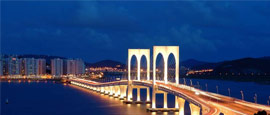Built in 1637 to guide ships through Macanese waters, the still-functioning Guia Lighthouse is also used to warn the city of impending typhoons. You can visit the surrounding fortress, which contains a chapel building noted for its frescoes. A series of wartime bunkers are cut into the hill nearby, and a small museum tells the stories of those who served here.
Things to see in Macau city
Tourist offices
Address: Largo do Senado, Edificio “Ritz”, Macau, China
Tel: +853 8397 1120
Opening Hours:
0900-1800
en.macaotourism.gov.moThere are five different tourist information offices around Macau, including two at ferry terminals and one at the international airport. The office listed below, on Senado Square, is the most centrally located.
Ascribed UNESCO World Heritage status in 2005, the old city encompasses more than two dozen squares and historical buildings. The colonial buildings, markets and narrow cobblestone lanes blend the feel of backstreet Porto with the synapse-jolting smells and sounds of southern China. Don’t miss the ruined facade of the Church of St Paul.
This warren-like temple complex of stone pavilions, gardens, statues and shrines is dedicated to A-Ma, the sea goddess after whom Macau is named. The spiritual atmosphere is frequently punctured by ear-splitting bursts of firecrackers, used to frighten away evil spirits. The earliest parts of the structure date back to 1488.
This leafy Oriental garden is filled with shady trees, lotus ponds, golden bamboo groves, grottoes and a bridge with nine turns (since evil spirits can only move in straight lines). Locals use the park to practise tai chi or play traditional Chinese musical instruments, and the pavilion in the centre of the pond is used for temporary exhibits.
Under a seashell-shaped glass roof in Coloane lies one of Macau’s biggest tourist draws. Raised walkways mean visitors have a unique vantage point of the resident giant pandas in an environment that is meant to resemble as closely as possible their natural habitat. The complex also houses enclosures for red pandas.
At 338m (1,109ft) high, the skyline-bossing Macau Tower grants wide views across to the Chinese mainland from the 61st-floor observation deck. It’s also a magnet for adrenaline junkies, who can skywalk the tower's perimeter, climb to its summit or brave the world’s highest bungy.
This preserved private residence dates back to 1869, giving rich insight into the lifestyle and cultural practices of the day. Its 60-plus rooms incorporate a range of different architectural styles, with both Asian and European influences. Guided tours are available on Saturdays and Sundays.
Macau's complex history is neatly chronicled in this excellent museum. The ground floor focuses on the maritime legacies of both China and Portugal, charting the discovery of the territory and its emergence as a trading port. Look out for sections detailing the history of cricket fighting (which presaged Macau's gambling industry) and the once-key firecracker industry.
Part of the colossally proportioned gambling-centred glitz of the Cotai Strip is this mega-resort. Named after its sister property in Las Vegas, the luxury Venetian is the largest casino complex on the planet and takes the Venice theme as far as humanly possible, with mock-Italianate architecture and canal-lined shops. It’s well worth a visit even if you’re not playing the tables.
This photogenic Portuguese plaza features facades in pastel tones of tangerine and lime, plus the stone grey neo-classical Correios e Telegrafos - one of Asia's finest post office buildings. Don’t miss the magnificent municipal chambers of the Leal Senado Building, complete with arched courtyards and blue and white patterned azulejo tiles.
Do you have any Feedback about this page?
© 2025 Columbus Travel Media Ltd. All rights reserved. No part of this site may be reproduced without our written permission, click here for information on Columbus Content Solutions.








 You know where
You know where